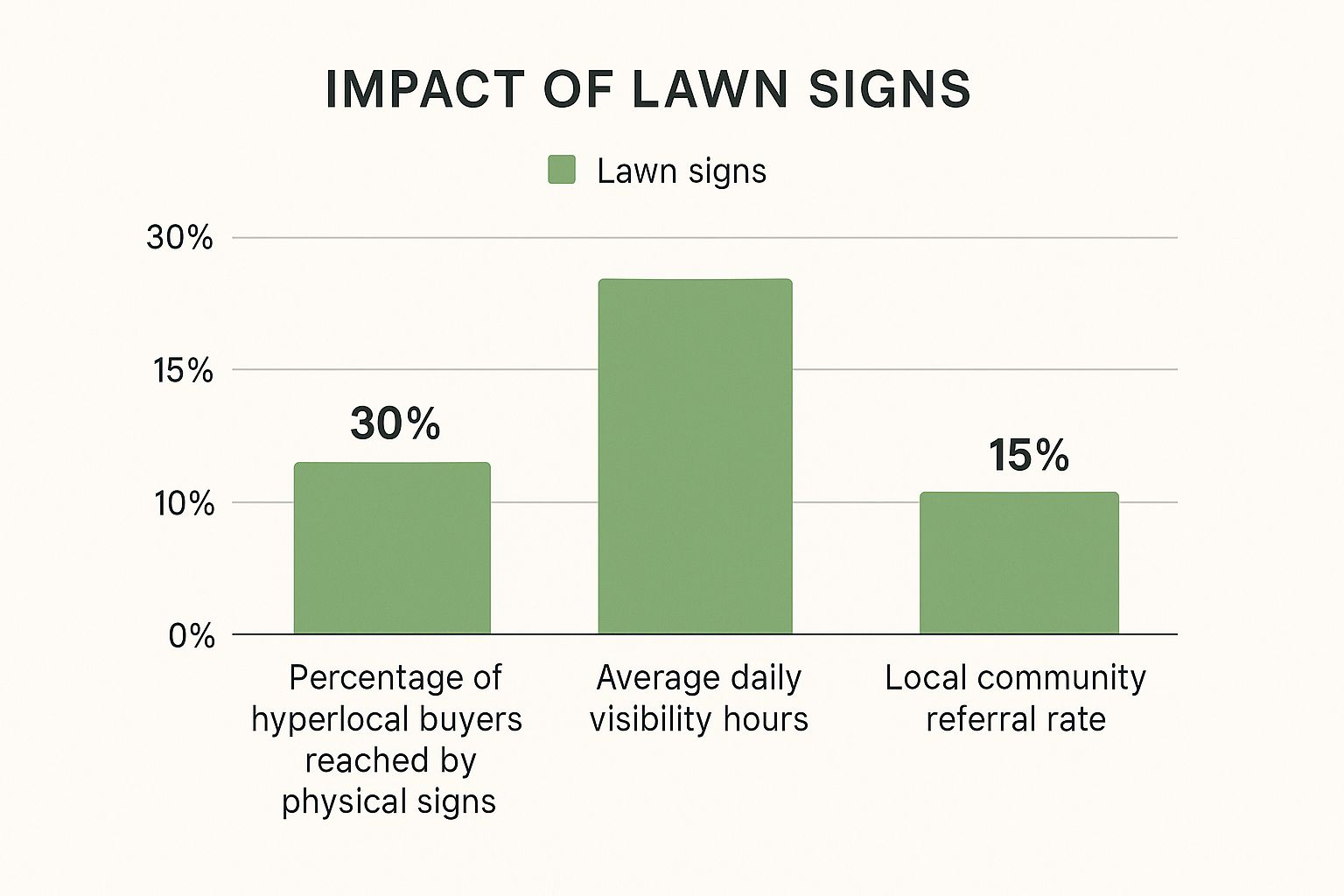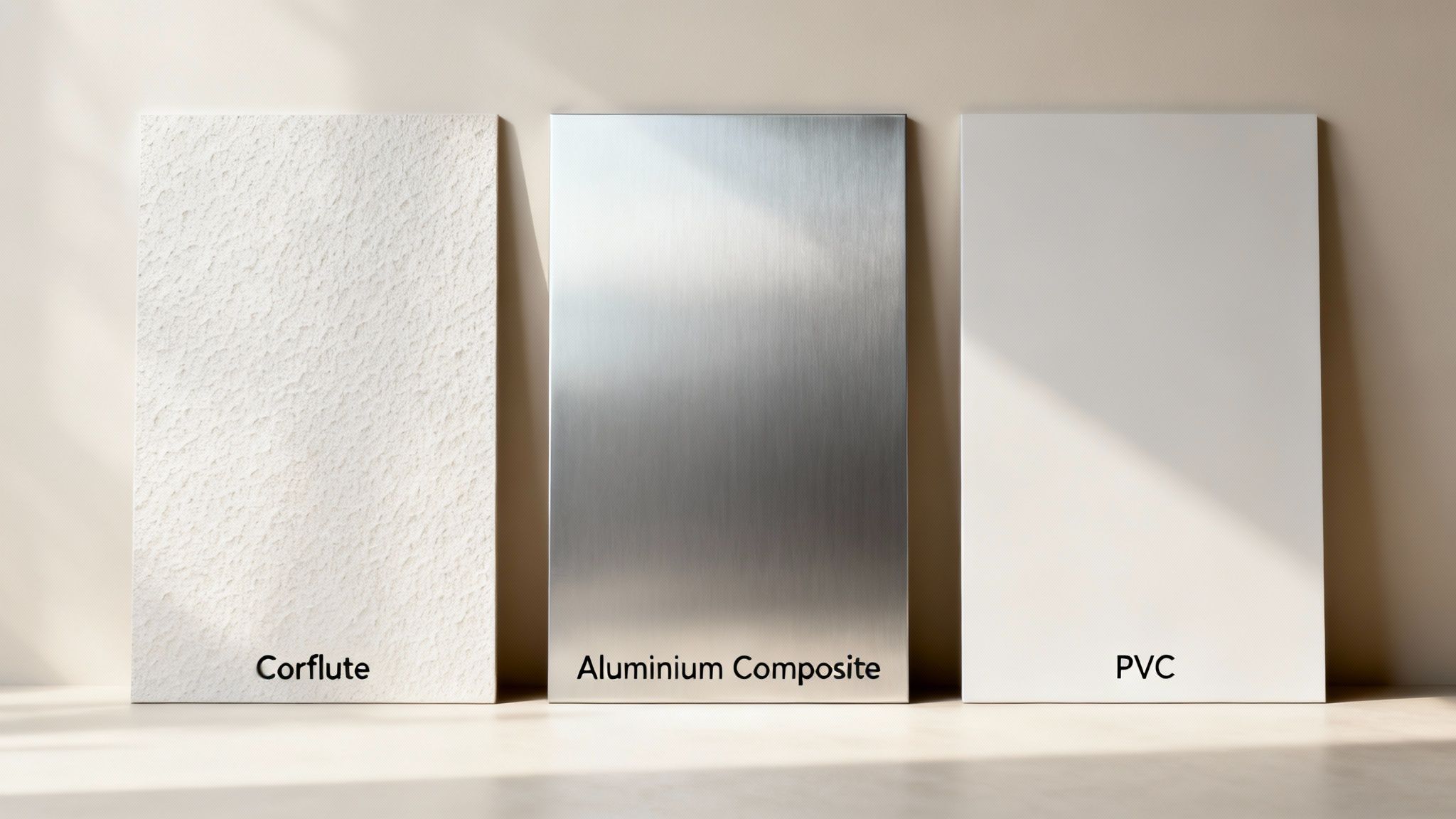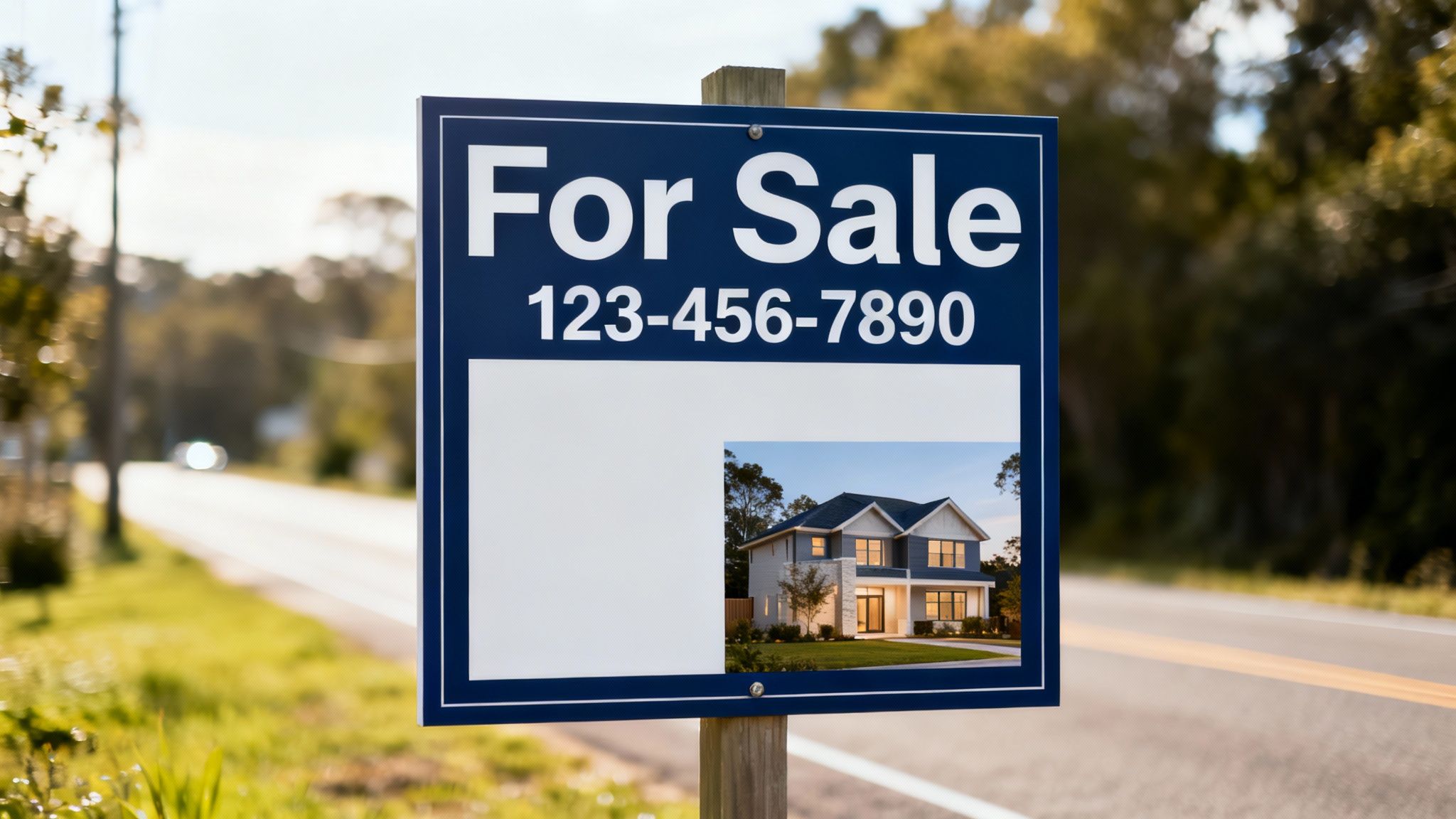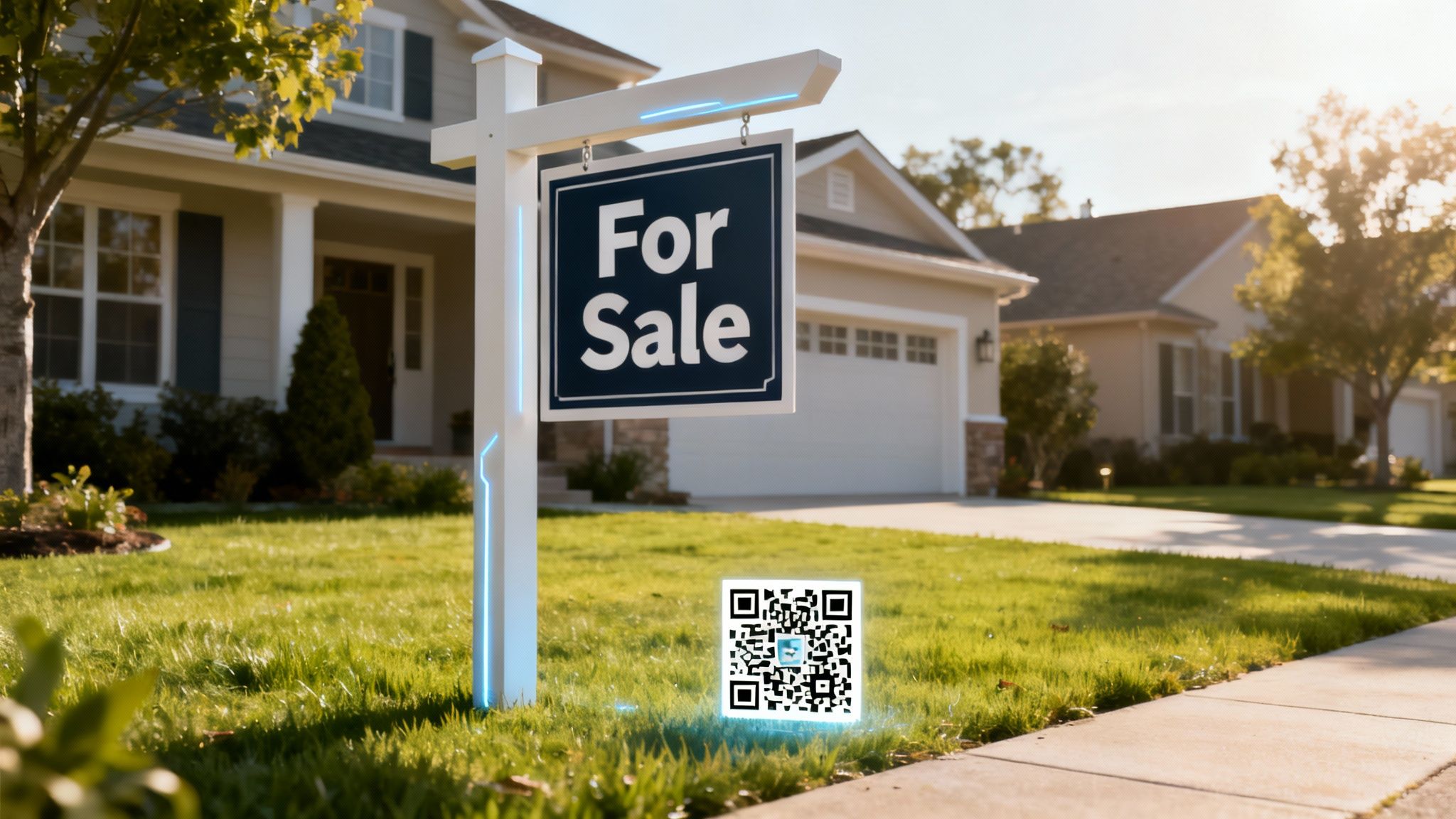Your cart is currently empty.

Even with all the property websites and apps we have today, the good old for sale sign stuck in your front lawn is still one of the most effective tools in your selling arsenal. It’s your silent, round-the-clock salesperson, grabbing the attention of a highly local audience that online ads can easily miss. This simple sign isn't just a tradition; it’s a smart, essential part of any modern property marketing plan.
Why Your For Sale Sign Still Matters
Picture your for sale sign as the physical front cover of your property's story. While online listings cast a wide net, a sign in your yard zeroes in on a motivated and often-forgotten group of buyers: the ones who are already exploring your neighbourhood. These are the people actively driving the streets, soaking in the local vibe, and scouting for their next home.
A physical sign creates an immediate, real-world connection that a digital ad simply can't. It instantly confirms your home is on the market, generates that all-important local buzz, and acts as a constant beacon for anyone who happens to pass by.
Capturing the Hyperlocal Market
Your neighbours can be your biggest allies. The moment a for sale sign goes up, they might think of a friend or relative who's been dying to move into the area. This kind of word-of-mouth marketing is pure gold, and it’s almost always triggered by a physical sign. You're tapping into a trusted network that no online algorithm can ever touch.
Then there are the "drive-by" buyers. These aren't just casual browsers; they're serious enough to be physically touring locations. Spotting your sign can turn a leisurely Sunday drive into a genuine enquiry, making it a powerful lead-generation machine that works for you 24/7.
A for sale sign is more than an announcement—it's an invitation. It signals to the community and potential buyers that this home is a real, active opportunity, turning passive curiosity into serious consideration.
The Power of First Impressions
A physical 'for sale' sign creates that critical first impression for people on the street, and it's just as important to nail the digital equivalent. Many people who see your sign will pull out their phone and look up the property right then and there. It's worth learning about the importance of web design as a digital first impression to make sure your online presence is just as polished and compelling.
This infographic breaks down the unique advantages a physical sign brings to the table, comparing its local reach, constant visibility, and power to spark community referrals.

As you can see, a physical sign offers continuous promotion and hooks a segment of buyers through local channels that purely digital campaigns might otherwise fail to reach.
Choosing the Right Sign Materials for NZ Weather

Ever wondered why some ‘For Sale’ signs look crisp and professional after a southerly blast, while others look a bit sad and floppy? It all comes down to the material. Here in New Zealand, a sign has to be tough enough to handle four seasons in one day—blistering sun, sideways rain, and those notorious gusty winds.
Think of your sign as the property’s first handshake. A flimsy, faded, or bent sign doesn’t make a great first impression. It can subtly suggest to buyers that perhaps the property itself hasn't been well cared for.
Choosing the right material from the get-go is a small but smart investment in your property's image. You need a sign that works hard for you 24/7, no matter what the weather report says.
Common Materials for NZ Conditions
When you’re looking at for sale signs, you’ll generally come across three main options in New Zealand. Each has its own strengths, so understanding the difference will help you match the sign to your property and budget.
1. Corflute (Corrugated Plastic)
This is the undisputed lightweight champion of real estate signs. It’s essentially a plastic version of cardboard, which makes it super affordable and a breeze to install. For a short sales campaign or temporary open home signs, Corflute is often the perfect choice. The trade-off? Its lightness means it’s not the best in a serious gale, and it can show wear and tear from the sun over a longer period.
2. Aluminium Composite Material (ACM)
If you're after a premium look that lasts, ACM is the top dog. It’s made of a tough polyethylene core sandwiched between two thin sheets of aluminium. This construction makes it incredibly rigid and weatherproof, so it won’t warp or fade. An ACM sign screams professionalism and quality, making it the ideal choice for high-end properties or a sales campaign that might take a bit longer.
3. PVC (Polyvinyl Chloride)
Sitting nicely in the middle, PVC offers a great balance. It's much tougher and more rigid than Corflute but usually easier on the wallet than ACM. PVC signs have a smooth, clean finish that’s brilliant for printing sharp graphics and photos, and they hold their own against both moisture and UV rays.
The material you choose sends a subtle message. A sturdy, pristine ACM sign can convey quality and seriousness, while a practical Corflute sign might be perfectly suited for a quick sale or a rental listing.
Comparing Your Options at a Glance
Choosing the right sign material can feel like a tough call, especially with our unpredictable weather. To make it easier, here’s a practical look at how the most common materials stack up for use in New Zealand.
Comparing For Sale Sign Materials in New Zealand
| Material | Durability | Typical Cost | Best Use Case |
|---|---|---|---|
| Corflute | Low to Medium | $ | Short-term listings, open home signs, and budget-conscious sales. |
| PVC | Medium to High | $$ | Mid-range properties or campaigns needing a quality look without the premium cost. |
| ACM | Very High | $$$ | High-end properties, developments, long-term listings, or when you need maximum professionalism. |
This table should give you a clear starting point for deciding what's best for your situation. At the end of the day, it's about matching the sign's performance to your property's needs and your budget.
Beyond the Classic Lawn Sign
While the standard rectangular sign stuck in the lawn is what we see most often, it’s not your only option. Depending on your property, a different format might grab a lot more attention.
- V-Signs: Absolutely brilliant for corner properties. They’re made of two panels joined at an angle, so they catch traffic from two directions at once. It's a simple way to double your sign's exposure.
- Window Decals: The perfect solution for apartments, townhouses, or any commercial space without a lawn. These stick right onto the glass, giving you great street-level visibility where a traditional sign just wouldn't work.
- Hanging Signs: Often seen in more established or upmarket neighbourhoods, these signs hang from a classic ornamental post. They just have a touch of class and elegance that can really make a property stand out.
Ultimately, picking the right sign is a balancing act between durability, budget, and the overall look you want to achieve. By thinking about your property type and how long you expect it to be on the market, you can choose a sign that represents your home perfectly right from day one.
Designing a Sign That Stops Traffic

Think of your for sale sign as a roadside billboard. You've got maybe three to five seconds to catch a driver's eye and get your message across. If your sign is a jumbled mess—hard to read, cluttered, or just plain boring—potential buyers will cruise right on by without giving it a second thought.
Effective sign design isn’t about stuffing in every last detail; it's about being smart and selective. By focusing on what really matters, you create a powerful marketing tool that makes people slow down, take notice, and actually do something.
This is where we move beyond just listing facts and start using the principles of sharp visual communication. Let's look at how colour, fonts, and layout can work together to turn a simple sign into a lead-generating machine.
The Science of Visual Hierarchy
Visual hierarchy sounds complicated, but the idea is simple. It's all about arranging things on your sign to guide a person's eye to the most important info first. Put yourself in a buyer's shoes: what do they absolutely need to know in that split second?
The most critical pieces of information are always:
- The words "For Sale"
- Your agency name or brand
- A clear, easy-to-read phone number
These three things should be the heroes of your sign—the biggest and boldest elements. Everything else, like the agent's name, website, or property features, is secondary and should be smaller. A sign that nails this gets its main message across instantly, even to someone driving past at 50 km/h.
Choosing Colours That Pop
Colour is your best friend when it comes to grabbing attention. The trick isn't just about using bright colours, but about choosing combinations with high contrast. This makes your text practically jump off the background, ensuring it’s readable from a distance and in any light.
Some classic, high-contrast pairings that always work are:
- Black text on a white or yellow background
- White text on a dark blue, red, or black background
- Dark blue text on a white background
Stay away from low-contrast combos like grey on white or yellow on light blue. They might look chic up close, but from the street, they just become a blurry mess. The goal here is instant clarity, not subtle artistry.
Your for sale sign is a direct reflection of your professionalism. A well-designed, high-contrast sign signals quality and competence, giving potential buyers confidence before they even step inside the property.
Typography That Speaks Volumes
The fonts you pick really set the tone. You need something that looks professional but is, above all, incredibly easy to read. Ditch the fancy, decorative script fonts—they’re a nightmare to decipher at a glance.
Stick to bold, clean, and simple sans-serif fonts like Helvetica, Arial, or Franklin Gothic for your main information. There's a reason they're the standard; they're designed for pure clarity. You might use a more distinct font for your logo, but the "For Sale" text and contact number have to be crystal clear.
The current New Zealand market shows just why standing out is so vital. With total housing stock expected to hit 30,721 listings by September 2025—an increase of 2.3% year-on-year—buyers have more options than ever. This creates a more balanced market, but it also means your property has to work harder to capture attention. You can discover more insights into the NZ property market trends and what they mean for sellers.
The Power of White Space and Imagery
Just like a great advertisement, what you don't put on your sign is as important as what you do. White space, which is just the empty area around your text and images, is crucial. It cuts down on clutter and helps the important bits stand out, giving them room to breathe and drawing the eye right to them.
If you’re including a photo, make it count. Pick one fantastic, high-impact shot that shows off the property's best asset—maybe a stunning exterior view or a beautifully renovated kitchen. A single, amazing photo is far more powerful than trying to cram in several tiny, unreadable images. Your aim is to pique curiosity and get people to look up the full listing online for the rest of the story.
Strategic Sign Placement and NZ Legal Rules
A beautifully designed 'For Sale' sign is one thing, but its true power is only unleashed when it's placed in the perfect spot. Think of it like a spotlight in a theatre – if it’s aimed even slightly off, the main actor stays in the shadows. The whole point of strategic placement is to make sure your sign grabs the maximum amount of attention from the right people: potential buyers driving or walking past.
The goal is to make your sign impossible to miss, but without it becoming an eyesore or a nuisance. This takes more than just plonking it in the middle of your front lawn. It actually requires a bit of on-the-ground reconnaissance to figure out the best sightlines, height, and angle to stop traffic and get people curious.
Of course, great visibility has to go hand-in-hand with staying on the right side of the law. Here in New Zealand, local councils have specific rules about where, when, and how you can display a real estate sign. Ignoring these bylaws can lead to fines and being forced to take your sign down, which pretty much torpedoes your whole marketing effort.
Maximising Your Sign's Visibility
To get the most out of your sign, you need to think like someone driving down your street. Before you even think about digging a hole, take a walk up and down the road from both directions. It’s a simple exercise, but it’s the best way to pinpoint the sweet spot that will catch the eye of approaching traffic.
Keep these key factors in mind:
- Find the Main Sightlines: Look for the spot on your property that gives oncoming cars the longest, clearest view. Is there a natural curve in the road that draws the eye towards a particular corner of your lawn? That's your spot.
- Check for Obstructions: Keep an eye out for anything that could block the view. The usual culprits are parked cars, overgrown bushes, low-hanging tree branches, and even power poles. A sign hidden behind a hedge is as good as no sign at all.
- Get the Height Right: The sign needs to be high enough to be seen over the bonnets of parked cars, but not so high that it’s out of a driver's immediate field of vision. A height of around 1.5 metres is usually a good starting point.
"A sign’s location is just as important as its message. The best design in the world is wasted if it’s placed where no one can see it. Spend five minutes observing traffic flow on your street—it’s the most valuable market research you can do."
Taking this tactical approach ensures your investment in a quality sign actually pays off by generating as many eyeballs on your property as possible.
Navigating NZ Council Bylaws
While getting noticed is the name of the game, following the rules is non-negotiable. In New Zealand, the placement of signs on public land—which includes the grass berm outside your property—is regulated by local councils. The rules can be quite different from one city to the next, so what’s okay in Auckland might not be in Wellington or Christchurch. Your first port of call should always be your local council’s website.
Here are some of the common regulations you’ll likely come across:
- Placement on Public Berms: Most councils are pretty strict about signs on the berm. Some might ban it altogether, while others will have specific limits on size and how long it can stay up.
- Sign Dimensions: There are often limits on how large a sign can be, particularly for residential properties.
- Duration: A sign can typically only be displayed while the property is actively for sale. It must be taken down within a few days of the property being sold or taken off the market.
These regulations are there to stop our streets from becoming a mess of visual clutter and to keep everyone safe by ensuring footpaths and sightlines for drivers remain clear.
The national property market in New Zealand has shown resilience, but regional trends can differ greatly, affecting how many signs you might see in a neighbourhood. In June 2025, while national new listings fell by 2.5%, some regions saw a significant increase. Gisborne, for instance, experienced a 25.8% jump in new listings, highlighting how local market dynamics can change. You can read the full report on NZ's property market shifts to get a better sense of these regional differences.
By balancing maximum visibility with a solid understanding of local rules, you can make sure your 'For Sale' sign works for you—effectively and legally—from the day it goes up until you proudly slap that "Sold" sticker on it.
Integrating Technology with Your Traditional Sign

Your physical for sale sign is brilliant at grabbing local attention, but its job doesn't have to stop at the kerb. By adding a touch of modern tech, you can build a bridge from the street to the screen, turning a static board into an interactive marketing hub.
Think of it this way: the sign is your initial handshake, but technology is the conversation starter that follows. It gives an interested passerby the exact info they want, right when their curiosity is highest. This simple upgrade turns your sign from a passive announcement into an active lead-generation machine.
The Power of the QR Code
The most direct and effective tech integration is the humble QR code. That little scannable square can be a portal to a huge amount of digital information about your property. With a quick scan from a smartphone, you can transport potential buyers from your front lawn to a specific online destination.
Instead of just linking to a generic homepage, think about where you want to guide their attention:
- The Full Property Listing: Send them straight to the detailed online listing with all the photos, floor plans, and property specs.
- A Virtual Tour: Let them dive into a 3D walkthrough or a guided video tour, giving them a feel for the home's layout and flow right from their phone.
- Open Home Schedule: Link to a page with upcoming viewing times, making it dead simple for them to pop it in their calendar.
A QR code effectively puts an open home in the palm of every potential buyer's hand, 24/7. It satisfies immediate curiosity and captures engagement at the peak moment of interest.
This instant access to information is incredibly powerful. You’re not just telling them the property is for sale; you're showing them why they should be interested, right then and there.
Beyond the Scan: Text for Info and Custom URLs
While QR codes are fantastic, they aren't the only way to make your sign "smart." Other simple technologies can deliver information and, more importantly, help you track interest and capture leads.
One popular method is a "Text-for-Info" service. The sign displays a simple instruction like, "Text '123Main' to 8888 for more photos and details." When someone sends the text, they automatically get a link to the property listing, and you receive their phone number as a new lead to follow up with. It's a brilliant way to build a list of genuinely interested buyers.
Another great option is to use a unique URL (web address) printed on the sign. Instead of your main website, you could use something memorable and easy to type, like 123MainStreetSale.co.nz. This makes it simple for someone to look up later and allows you to track exactly how many visitors came directly from seeing your physical for sale sign.
To truly modernise your physical 'for sale' sign, consider how other businesses transform their operations using digital loyalty solutions to engage customers beyond a single interaction. The same principle of using technology to create a seamless connection applies here, turning a one-off viewing into a lasting lead. By integrating these simple but effective digital tools, your traditional sign becomes a far more intelligent part of your overall marketing strategy.
Common Questions About For Sale Signs
Putting up a for sale sign might seem like a straightforward part of selling your home, but it often brings up a bunch of practical questions. What are the rules? What happens after the sale? Getting these details sorted helps you feel confident in your sales process.
Let's dive into some of the most common questions we hear from sellers here in New Zealand.
Do I Legally Have to Use a For Sale Sign?
This is one of the first things people ask, and the answer is simple: no. There's no law in New Zealand that says you must have a for sale sign on your lawn to sell your property. The choice is completely yours, in discussion with your real estate agent.
But just because it’s not legally required doesn’t mean it’s not essential. Think of a sign as your silent, 24/7 salesperson. It grabs the attention of neighbours who might know someone looking to buy, and it catches the eye of serious buyers actively driving around your area. While you don't have to use one, it's a cornerstone of any solid marketing plan for a reason.
How Much Does a Professional For Sale Sign Cost?
The cost for a professional sign can vary quite a bit, really depending on what it's made of, how big it is, and the design itself. Having a rough idea of the budget helps you decide what's best for marketing your property.
Here’s a general idea of what to expect:
- Basic Corflute Signs: These are your most affordable option. They're lightweight, easy to make, and perfect for short-term use like pointing the way to an open home.
- Mid-Range PVC Signs: A definite step up in quality. PVC signs look more polished, last longer, and strike a great balance between cost and a professional appearance.
- Premium ACM Signs: For that top-of-the-line look, you can't beat Aluminium Composite Material (ACM). These signs are incredibly tough, look sharp, and are the go-to for high-end properties or if you expect a longer sales campaign.
A good way to think about it is that your sign's cost is a small, but vital, piece of your overall marketing investment. A quality sign can lift the perceived value of your property and pull in more serious buyers, making it money well spent.
How Long Does the Sign Stay Up After the House Sells?
Once you've got a signed contract and the sale is unconditional, the standard practice isn't to take the sign down straight away. Instead, your agent will add a "Sold" sticker right over the "For Sale" part.
This does a couple of important things. First, it lets other potential buyers and the rest of the neighbourhood know the property is off the market. Second, it acts as a great advertisement for your real estate agent, showing everyone they get results.
The sign, with its shiny new "Sold" sticker, usually stays put until settlement day—the day the keys are officially handed over. Your agent will then arrange to have it collected on or just after that date, wrapping up a successful sale.
At SONI DESIGN, we know a for sale sign is much more than a piece of plastic on a lawn—it’s the first impression your property makes. We're passionate about creating professional, eye-catching signs that make your listing the one everyone remembers. Let's work together to design a sign that not only gets noticed but also reflects the true quality of your home. Start designing your perfect for sale sign with us today!
Leave a Comment
Stay home & get your daily
needs from our shop
Start You'r Daily Shopping with Nest Mart
Best prices & offers
Orders $50 or more
Free delivery
24/7 amazing services
Great daily deal
When you sign up
Wide assortment
Mega Discounts
Easy returns
Within 30 days
